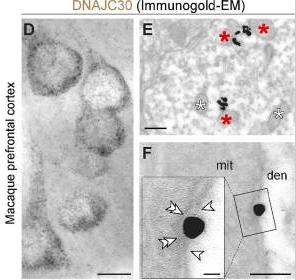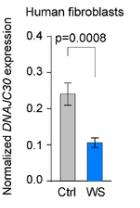Recombinant Human DNAJC30 protein(Ser39-Gly124), His-tagged
| Cat.No. : | DNAJC30-512H |
| Product Overview : | Recombinant Human DNAJC30 (Q96LL9) (Ser39-Gly124) was expressed in E. coli with a polyhistide tag at the N-terminus. |
- Specification
- Gene Information
- Related Products
- Case Study
- Application
- Download
| Species : | Human |
| Source : | E.coli |
| Tag : | His |
| Protein Length : | Ser39-Gly124 |
| Form : | Lyophilized from sterile PBS, pH7.4. Normally 5 % - 8 % trehalose, mannitol and 0.01% Tween80 are added as protectants before lyophilization. |
| Molecular Mass : | The recombinant human DNAJC30 consists of 101 amino acids and predicts a molecular mass of 11.4 KDa. It migrates as an approximately 14 KDa band in SDS-PAGE under reducing conditions. |
| Purity : | > 95 % as determined by SDS-PAGE |
| Storage : | Samples are stable for up to twelve months from date of receipt at -20°C to -80°C. Store it under sterile conditions at -20°C to -80°C. It is recommended that the protein be aliquoted for optimal storage. Avoid repeated freeze-thaw cycles. |
| Reconstitution : | It is recommended that sterile water be added to the vial to prepare a stock solution of 0.2 ug/ul. Centrifuge the vial at 4°C before opening to recover the entire contents. |
| Gene Name | DNAJC30 DnaJ (Hsp40) homolog, subfamily C, member 30 [ Homo sapiens ] |
| Official Symbol | DNAJC30 |
| Synonyms | DNAJC30; DnaJ (Hsp40) homolog, subfamily C, member 30; WBSCR18, Williams Beuren syndrome chromosome region 18; dnaJ homolog subfamily C member 30; Williams Beuren syndrome chromosome region 18; williams-Beuren syndrome chromosomal region 18 protein; WBSCR18; MGC12943; |
| Gene ID | 84277 |
| mRNA Refseq | NM_032317 |
| Protein Refseq | NP_115693 |
| UniProt ID | Q96LL9 |
| ◆ Recombinant Proteins | ||
| DNAJC30-2454M | Recombinant Mouse DNAJC30 Protein, His (Fc)-Avi-tagged | +Inquiry |
| DNAJC30-512H | Recombinant Human DNAJC30 protein(Ser39-Gly124), His-tagged | +Inquiry |
| DNAJC30-4715M | Recombinant Mouse DNAJC30 Protein | +Inquiry |
| DNAJC30-2761H | Recombinant Human DNAJC30 Protein, GST-tagged | +Inquiry |
| DNAJC30-1297R | Recombinant Rhesus monkey DNAJC30 Protein, His-tagged | +Inquiry |
| ◆ Cell & Tissue Lysates | ||
| DNAJC30-6872HCL | Recombinant Human DNAJC30 293 Cell Lysate | +Inquiry |
Case 1: Tebbenkamp ATN, et al. Cell. 2018
While copy-number variations (CNVs) drive neurodevelopmental disorders like Williams syndrome (WS), their mechanistic ties to neural phenotypes remain unclear. This study identifies mitochondrial dysfunction via 7q11.23-encoded DNAJC30, an ATP-synthase interactor, as central to WS pathogenesis. Dnajc30 deletion in mice caused mitochondrial hypofunction, impaired neuronal morphology, and WS-like behaviors, aligning with reduced oxidative phosphorylation supercomplex integrity in WS patients. These findings position DNAJC30 as an ATP-synthase auxiliary component, unveiling mitochondrial deficits as a key driver of brain abnormalities in WS.

Fig1. Macaque dorsolateral prefrontal cortex labeled using anti-DNAJC30 and silver-enhanced 1.4nm gold.

Fig2. Expression ratio (DNAJC30:TBP) in human fibroblasts.

Fig1. Scheme of the DNAJC30 protein domains and location of the variants. (Sinja Kieninger, 2022)
Not For Human Consumption!
Inquiry
- Reviews
- Q&As
Ask a Question for All DNAJC30 Products
Required fields are marked with *
My Review for All DNAJC30 Products
Required fields are marked with *
Inquiry Basket


